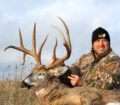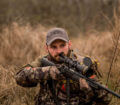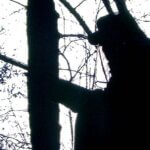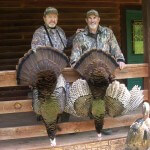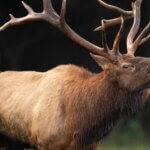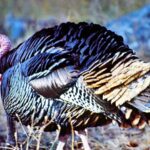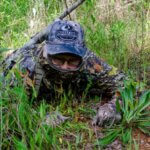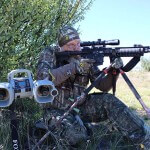 Editor’s Note: Can you identify a buck fast and get off a clear shot before he vanishes in thick brush? Although not easy, there are ways you can speed-up your reaction time. How does a batter see a ball coming toward the plate at 90 mph, and time his swing to hit the ball? Travis Fryman, who played with the Detroit Tigers and the Cleveland Indians for 13 years, batting in 1,022 runs, making 223 home runs and five times earning MLB All Star status, says, “I not only can see the ball as it leaves the pitcher’s hand, but I also can see the seams of ball as it rotates toward me.” Fryman, a longtime hunter and fisherman, uses his vision skills he sharpened working with a developmental optometrist on his baseball hitting to hunt more effectively. The quicker you can see and identify a buck and determine the direction he’s traveling, the quicker and more accurately you’ll shoot. You must understand the difference between eyesight and vision. If you start now, by the time deer season arrives in the fall, your ability to see deer greatly will have improved. NFL teams use developmental optometrists to teach quarterbacks to spot open receivers. One friend of our son’s went to a developmental optometrist for 6 months to improve his vision to get accepted into the Navy pilot program.
Editor’s Note: Can you identify a buck fast and get off a clear shot before he vanishes in thick brush? Although not easy, there are ways you can speed-up your reaction time. How does a batter see a ball coming toward the plate at 90 mph, and time his swing to hit the ball? Travis Fryman, who played with the Detroit Tigers and the Cleveland Indians for 13 years, batting in 1,022 runs, making 223 home runs and five times earning MLB All Star status, says, “I not only can see the ball as it leaves the pitcher’s hand, but I also can see the seams of ball as it rotates toward me.” Fryman, a longtime hunter and fisherman, uses his vision skills he sharpened working with a developmental optometrist on his baseball hitting to hunt more effectively. The quicker you can see and identify a buck and determine the direction he’s traveling, the quicker and more accurately you’ll shoot. You must understand the difference between eyesight and vision. If you start now, by the time deer season arrives in the fall, your ability to see deer greatly will have improved. NFL teams use developmental optometrists to teach quarterbacks to spot open receivers. One friend of our son’s went to a developmental optometrist for 6 months to improve his vision to get accepted into the Navy pilot program.
Moving ever so slowly, and intensely conscious of my surroundings, I slipped silently down an old logging trail. As I walked, stopping periodically, my eyes searched the cover. Some 50 yards away, between two trees and just behind some low brush, I saw a line parallel to the ground. A fallen tree, or the back of a deer? I wondered. But which was it?
 I could see something extending behind the cover from the parallel line. I couldn’t tell, however, whether I was looking at a limb or at the neck of a deer. And, if it was a deer, I wasn’t certain if it had antlers. For 10 minutes, I stared. If the vision in front of me was a deer, it would be an easy shot for my .30/06. The opportunity to take a buck might have been standing in front of me – but I didn’t know for sure. Finally, my patience at an end, I decided to move in a little closer. When I stirred, the deer took flight. I watched his massive rack vanish.
I could see something extending behind the cover from the parallel line. I couldn’t tell, however, whether I was looking at a limb or at the neck of a deer. And, if it was a deer, I wasn’t certain if it had antlers. For 10 minutes, I stared. If the vision in front of me was a deer, it would be an easy shot for my .30/06. The opportunity to take a buck might have been standing in front of me – but I didn’t know for sure. Finally, my patience at an end, I decided to move in a little closer. When I stirred, the deer took flight. I watched his massive rack vanish.
Every hunter can recount similar experiences. And, no matter how skilled we are as stalkers, how accurate we are as shooters, how well we select guns, ammunition and terrain to hunt, our hunts will be fruitless without the ability to see deer. This week we’re exploring vision and how it impacts your hunting deer, as well as game birds and small game.
A developmental optometrist can determine in what area a hunter’s visual skill is deficient and then can develop a personalized therapy program to improve those skills. For a listing of doctors in your area, contact the non-profit Optometric Extension Program Foundation at https://www.oepf.org or 410-561-3791. Check out the American Optometric Association (www.aoa.org).
To learn more about hunting deer with John E. Phillips’ Amazon Kindle eBooks, print books and Audible books and Nook books, click here at https://johninthewild.com/books/#deer. You can type in the name of the book and download it to your Kindle, and/or download a Kindle app for your iPad, SmartPhone or computer. For a free download on how to make jerky from venison to provide a protein-rich snack, choose “How to Prepare Venison Jerky: The Ultimate Snack Food” at johninthewild.com/free-books.

